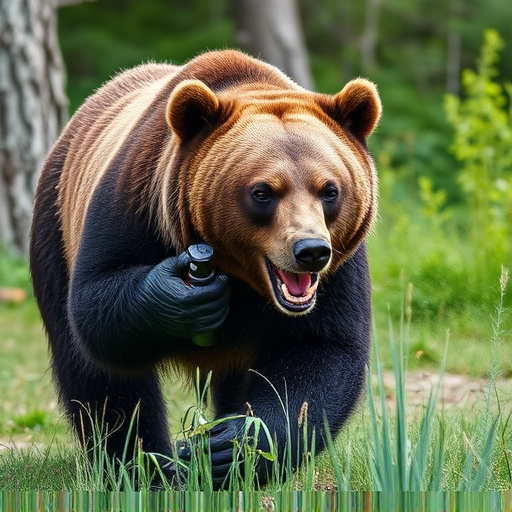Bear spray, a crucial outdoor safety gear for bear country, uses capsaicin (2%-4% ppm) as its active ingredient to irritate bears' eyes and respiratory system. Higher capsaicin concentrations (15%-30%) are recommended for backcountry activities where encounters with aggressive bears are more likely. Proper usage involves aiming at the bear's face from a safe distance (recommended by manufacturers). Regular maintenance ensures the spray remains effective.
“Enhancing your wilderness adventures with bear spray can be a game-changer for safety. This essential gear offers a non-lethal deterrent against potential bear encounters, providing crucial time for escape and evasion. In this article, we explore the core components of bear spray safety: understanding its active ingredient, capsaicin concentration, selecting the right product for your needs, and adopting best practices for safe handling. By deciphering these aspects, you’ll be better equipped to navigate the wilderness with enhanced peace of mind.”
- Understanding Bear Spray: A Vital Wilderness Safety Gear
- Deciphering Capsaicin Concentration: The Key to Effectiveness
- Choosing the Right Bear Repellent for Your Adventure
- Safe Handling and Usage Practices for Optimal Protection
Understanding Bear Spray: A Vital Wilderness Safety Gear
Bear spray is a crucial addition to any outdoor enthusiast’s wilderness safety gear, especially when venturing into bear country. It acts as a non-lethal deterrent, designed to protect against aggressive bears and provide time for escape or retreat. The key active ingredient in most bear sprays is capsaicin, the same compound that gives chili peppers their heat. This chemical irritates a bear’s eyes, nose, and respiratory system, causing them to flee the area rapidly.
The effectiveness of bear spray lies in its capsaicin concentration, typically measured in parts per million (ppm). Higher concentrations offer more protection, especially against larger bears. When choosing bear spray, look for products with capsaicin levels ranging from 2% to 4%, ensuring a powerful yet controllable reaction. Proper usage involves aiming the spray at the bear’s face and eyes, creating a barrier of irritant that discourages an attack. Understanding how to use bear spray correctly is paramount, as improper deployment could lead to inadequate protection or even injury.
Deciphering Capsaicin Concentration: The Key to Effectiveness
Understanding the capsaicin concentration in your bear repellent is crucial for ensuring its effectiveness. Capsaicin, the active ingredient in bear spray, is measured in parts per million (ppm). The higher the ppm, generally, the more potent the spray will be in deterring bears.
Manufacturers often provide this information on the product label or packaging. Look for a concentration that aligns with your needs and the specific bear encounters you anticipate. Keep in mind that different concentrations may have varying ranges of effectiveness against black bears versus grizzly bears, so always consult local guidelines and recommendations tailored to your region’s wildlife.
Choosing the Right Bear Repellent for Your Adventure
When venturing into bear country, selecting the appropriate bear repellent is a crucial step for your wilderness safety gear. Not all repellents are created equal; the effectiveness heavily depends on the capsaicin concentration. Active ingredients with higher concentrations of capsaicin, often ranging from 15% to 30%, offer robust protection against aggressive bears. These levels send a strong signal to bears, deterring them from approaching.
Consider your specific activity and environment when making this choice. For example, if you’re primarily hiking on trails with occasional bear sightings, a lower concentration might suffice. However, for remote backcountry camping or hunting expeditions where encounters are more likely, opt for a higher capsaicin content to ensure maximum protection.
Safe Handling and Usage Practices for Optimal Protection
When it comes to safe handling and usage practices for bear spray, understanding the capsaicin concentration is key. Capsaicin, the active ingredient in most bear repellents, acts as a irritant to an animal’s eyes, nose, and lungs, deterring them from approaching. Products with higher capsaicin concentrations typically offer greater protection, but it’s crucial to use them responsibly. Always follow manufacturer instructions, ensuring you’re at least 20-30 feet away from the bear when spraying, and aim for the animal’s face and chest.
Proper usage involves a quick, short burst of spray rather than a prolonged application. This technique maximizes the spray’s effectiveness while minimizing its impact on surrounding areas and your own safety. Regularly inspecting and maintaining your bear spray is equally important. Check expiration dates, ensure the nozzle is intact, and store it in a cool, dry place to preserve its potency. Remember, proper handling and usage are vital for optimal protection in the wilderness.
Bear spray is an indispensable tool for anyone venturing into bear country, offering a safe and effective means of deterring attacks. By understanding the capsaicin concentration levels and selecting the right product, adventurers can enhance their wilderness safety. Proper handling and usage practices are crucial to ensure optimal protection during outdoor activities where bears roam. Remember, knowledge and preparation are key to staying safe in these natural habitats.
